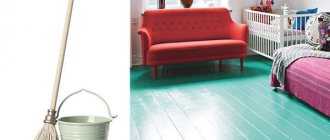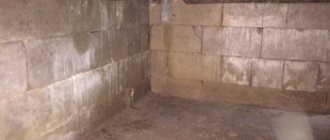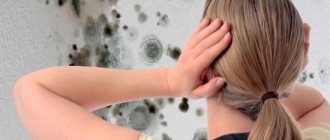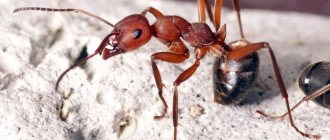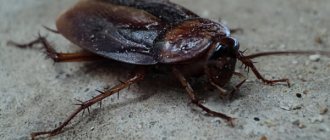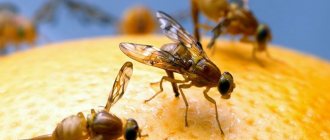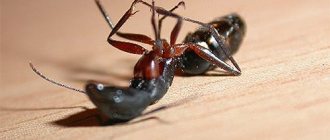Infection with fungus and mold on wooden floors is a common problem faced by home and bathhouse owners.
Spores actively develop in a suitable habitat, so it is impossible to get rid of them using wet cleaning.
To effectively eliminate fungus in the underground, it is necessary to find out the cause of its appearance, remove the formations and, if necessary, replace the floor covering.
Types of fungus and causes of its appearance
Before you start fighting fungus in a wooden house, you need to find out the reasons for its appearance, determine the boundaries of its spread, and then move on to choosing a composition for treatment. The most common types of this pest found in buildings made of logs or timber are:
- White house fungus. It develops most quickly, covering a large area with mycelium, constantly increasing it. The best conditions for emergence are formed, as a rule, underground. Also often fungus is found under the floor or in the basement;
- Rotting fungi. There are several types that differ in color and appearance - white brown and bacterial. They most often appear near places with high humidity, for example, near water pipes, although dry rot also occurs;
- Blue fungi. A very dangerous pest that can penetrate wood, destroying the varnish or paint coating. Despite the fact that they do not cause serious consequences for the strength and integrity of the tree, they often act as a harbinger of the appearance of more dangerous types of fungus. In addition, they give the surface of logs and beams an extremely unpleasant bluish tint;
- Actinomycetes. They are a cross between algae and fungi. They have an extremely destructive effect on wood, quickly reducing its strength;
- Mold fungus. A universal pest that can exist not only on wood, but also on concrete, fabrics, stone and even ceramic tiles. They have spores that are extremely harmful to humans; in addition, they give contaminated surfaces of building structures an extremely unpleasant appearance.
Most often, fungus appears in the subfloor of a wooden house and its other structures for one reason - due to increased humidity levels. Therefore, it is quite logical to begin the fight against this extremely harmful phenomenon by creating an effective ventilation system that can ensure rapid and effective removal of moisture from the premises of the building.
Identifying different types of fungus is quite simple. Among its typical manifestations are the following: a sharp and damp smell, stains and darkening on wooden surfaces located in different places, wet areas in the corners of the building, on the floor or walls, etc. It should be noted that removing the fungus is not as easy as it might seem at first glance. Therefore, you should study the sequence of work very carefully. Naturally, you should not forget about choosing an effective remedy for fungus.
By the way, are the boards impregnated with bioprotection?
In theory, all your subfloor boards should have been treated with bioprotection before installation. Note that this does not prevent mold from forming on top of the boards. But if biosecurity has not been done at all, treatment needs to be carried out. Be sure to use a respirator and be extremely careful under the floor, staying as little in the underground space as possible.
That's probably all. It should work. If you can offer your ideas, materials and actions to get rid of dampness under the floor, please send them by email for publication here.
PS What if nothing helps? — Try forced ventilation. In stores that sell all kinds of fans and ventilation pipes, you can buy a fan - from the simplest one, which is placed in the bathtub at home, to more powerful ones. You can try the simplest one, but it will be of little use (although for small areas the effect will also be noticeable after a day or two of work). Insert the fan into the hole in the foundation from the inside so that it draws air out, make an extension cord and run it for a long time. You can also put a heat gun in the underground and try to dry it with it. It is clear that you will not turn it on all the time, only temporarily and not forgetting about electrical safety in a damp room.
PPS Once again, I would like to draw your attention to the fact that it is worth installing hatches in the house when constructing the floor. And in such quantities that you can climb through them into the desired part of the room. However, remember that in winter these hatches will require insulation, so do not overdo it.
(c), Nick Masterov, especially for ELport.ru
Basic means for combating fungus and mold
A set of works that makes it possible to remove mold and mildew in wooden houses with a high degree of probability includes the following operations:
- Cleaning wooden surfaces from detected pests using a variety of mechanical means, starting with scrapers and sandpaper, and ending with a grinder with an abrasive attachment;
- Thorough treatment of infected areas, and, if there is a sufficient amount of antifungal composition, of all wooden surfaces;
- Removal of wooden structures damaged by fungus or their individual places.
Naturally, it is not enough to simply treat a wooden house against fungus. As noted above, it is extremely important to install an effective ventilation system, as well as, where necessary, high-quality waterproofing. Only in this way will the main cause of the appearance of fungus, rot and harmful microorganisms be eliminated - high humidity.
In order to effectively remove fungus in the basement of a wooden house or on other structural elements of a building, various means can be used. The most popular today are several formulations. Firstly, the saber, which is made on the basis of sulfur, is deservedly among the most effective. Buying this drug is quite simple, as it is sold in most household supply and building materials stores. It is extremely harmful and dangerous for humans, therefore it is used only in closed and temporarily isolated rooms, which are allowed to be entered after 10-12 hours after lighting the checker.
Secondly, chlorine-containing compounds, for example, bleach, are quite in demand. When working with them, the use of protective clothing is required, including the mandatory presence of a respirator, since a highly concentrated solution is most effective. After treatment, the room should be thoroughly ventilated.
Thirdly, owners of wooden houses often choose to use various antiseptic compounds. This is explained by the fact that modern drugs, as a rule, have a complex effect and are able to effectively fight, including mold and mildew.
Special antifungal primers are also noticeably popular. They are very effective and not only remove areas of fungus and mold, but also prevent the reappearance of pests. The composition is applied in several layers using a regular brush. Before using such primers, you should carefully prepare the base, cleaning it to uncontaminated areas of the wood.
In addition, a folk remedy is often used, which is a solution of various types of sulfate - copper or iron. The choice of a specific option depends on the preferences of the homeowner. However, in any case, when using, you must carefully follow the instructions for use.
Share on social media networks:
If mold and mildew appear in the house, how to get rid of unpleasant phenomena? Microorganisms often infect the walls and flooring of a wooden house, which causes a lot of trouble for its residents. A tree on which fungus has begun to appear loses its attractive appearance. And the education itself has a very negative impact on the health of all household members. Based on this, mold and mildew on the surface of the wood should be eliminated immediately, before it spreads throughout the house.
As soon as you notice white, cotton-like formations or white fluff on the walls and floor, without wasting time you need to find the reason for its appearance and the places in which it has settled. If for some reason you do not do this, yellow, purple and pink traces of the fungus may appear on the tree in the future, which will eventually become covered with a gray-silver film. It is almost impossible to eliminate such formations.
Causes of wood destruction
Let's assume that the inside of the house was lined with absolutely healthy boards. However, over time, they also began to turn blue and gradually become covered with ugly stains. What does this come from?
Mold reproduces by spores that are present absolutely everywhere - in the forest, in the fields, on the roads. It is estimated that forest-dwelling species living on living trees cover approximately 40% of the surface area of the trunks and branches of these trees and shrubs. They do not destroy bark and other tissues, but make them more porous.
Spores are easily carried by wind, animals and even shoes. If microorganisms, by any of the listed methods, enter a house where favorable conditions have been created for them, they quickly begin to multiply. The ideal conditions for the existence of mold are high humidity (from 70%) and temperature from +5ºС to +30ºС.
Good ventilation and moderate humidity are two conditions necessary to prevent mold in areas where water is constantly used, such as the bathroom
Wood is just one of the materials on which entire colonies of fungi settle. They can grow on rubble stone, concrete, plaster, paper and even plastic.
Owners of seasonal country houses in central Russia know very well: if you do not regularly heat a wooden house or do not monitor the condition of the basement and foundation, then dark spots will certainly appear in the corners, on the ceiling and even on the furniture.
The same problem threatens cellars and wooden baths if ventilation is not organized in them. Even the interior lining of the clapboard can become infected with fungus and become completely unusable if it does not have the opportunity to ventilate and dry out.
The lack of air circulation also favors the rapid growth of mold colonies. This can be seen in city apartments, where bathrooms are lined with wood panels and ventilation is poor.
If the surface of the panels is not treated with a protective compound, they will soon become covered with a light white or black coating, and over time the cladding will take on a neglected appearance.
Pinotex Base – deep impregnation for the top layer of wood, acts as a primer and antiseptic. Used in combination with decorative products - Pinotex Wood Oil, Pinotex Classic, etc.
Thus, the reasons for the appearance of fungus or mold are the lack of waterproofing, disruptions in ventilation, and high air humidity.
Types of fungus
If fungus occurs in the house, not everyone knows its consequences and how to deal with it. And at the same time, any type of fungus is very dangerous for wood products. They contribute to the destruction of wood fibers. As a result, if harmful formations are not eliminated in a timely manner, a house made of wood may completely collapse to the very foundation. Fungal spores can spread through the air or be carried on clothing or animal fur.
Important! In ancient times, buildings infected with this kind of pest were burned to protect other buildings from being affected by this “disease.”
White house mushroom
It contributes to the destruction of the wood structure, changes in its color and the appearance of cracks.
Blue fungi
When such formations appear, the wood acquires a gray-blue tint. Bacteria destroy varnish and paint. Thus, moisture gets inside the products.
Rotting fungi
There are wet and dry rot:
- Wet damages damp wood that is near the ground or drainpipes. Affected products become loose and dark lines form on them.
- Dry, in turn, manifests itself as reddish dust in the corners and multiplies quickly in a humid environment. Gray stripes appear on the tree, destroying the wood fibers.
White and black mold
This type of microorganisms can form not only on wooden surfaces. Stone, concrete tiles and various fabrics can become a place for the emergence and active reproduction of fungus. In addition to its destructive effect on various materials, mold is very harmful to human and animal health. Therefore, if a fungus appears in the house, its consequences and how to deal with it still need to be clarified, and as quickly as possible.
How to prevent mold from reoccurring
If mold has taken place, then nothing will prevent it from appearing again. You need to create conditions under which it will be uncomfortable for her to reproduce and live in your house and basement.
- First of all, this is to ensure good and constant ventilation of the room.
- The walls should not be filled with furniture or littered with rubbish. The air should circulate well in the room.
- Check to see if rainwater is getting into the underground and if there are any traces of groundwater.
- If you notice that your neighbors have mold and the buildings are located quite close to your home, then preventive treatment with an antiseptic against mold can be carried out twice a year.
Mold spores are constantly in the air, and we live in friendly neighborhoods with them, but whether we allow mold to break into our space is another matter. The main thing to remember here is that everything is in our hands, the rules for preventing mold are very simple!
Causes of fungus
Methods for dealing with fungus in a wooden house will be useful not only for people who live in a private house and in damp or swampy areas. Sometimes in apartments fungus can appear, at first glance, out of nowhere.
Many people ignore the presence of an unpleasant smell or black corners in the room and simply re-stick the wallpaper or re-lay the floor. Damp green or blackened basement walls do not interfere with food storage. And the appearance of shortness of breath, headaches and other diseases is mainly attributed to the weather or age.
In order to prevent the fungus from spoiling the health and decoration of the room, it is better to prevent its appearance in the house. It's much easier than dealing with the consequences. To avoid harmful spores in your home, you should know the reasons for their occurrence.
The main reason that fungus has appeared in the house and you are thinking about how to get rid of it is moisture from the ground or high humidity in the underground covering:
- Dampness penetrates the floor covering and infects the walls with fungus.
- Damp apartments on the first floors of multi-story buildings are an excellent habitat for toxic mold spores.
- Insufficient room ventilation contributes to the appearance of dampness.
- Growing many indoor plants in small spaces that require constant humidity.
- Improper use of humidifiers is also a cause of mold.
Prevention measures
After the fungus in the cellar is destroyed, care must be taken to ensure that it does not reappear. Preventive measures will help with this.
- Insulate the building and install waterproofing.
- Make it a rule to regularly inspect rooms where excess dampness may appear, paying special attention to corners, joints and places where sunlight does not penetrate or is extremely rare.
- Ventilate the basement, avoid dampness.
- Treat all surfaces, both wooden and other materials, with a fungicidal antiseptic.
If you are in the process of construction, listen to the advice and take care in advance to prevent fungus from settling in the house.
- A ventilation device will avoid problems with dampness. If it is impossible to design a supply and exhaust system, at least make windows for ventilation. It would be good if sunlight would also penetrate through them.
- Insulate the foundation and waterproof the basement and subfloor.
- Building materials should be treated with an antiseptic.
- It would be good if heating was provided in the basement.
How to get rid of fungus in a wooden house under the floor?
If you have a fungus in your home, before looking for methods to remove it, you need to eliminate the cause of its occurrence. Otherwise it will appear again and again. The technology for removing mold in a private home is not based only on wet cleaning and removal of visible contaminants. One of the main conditions for obtaining a successful result is to establish an indoor climate in which fungus cannot appear.
- First of all, be sure to remove fungal deposits, rotten and rotten parts of the wood.
- Individual areas should be cleared of fungus using an ax or plane.
- Items and furniture that cannot be cleaned will have to be thrown into the trash.
- Remove the top layer of soil from the subfloor. Fungus on wooden floors and walls indicates contamination of the ground under the floor.
- To prevent the fungus from spreading, fill the perimeter of the underground with the following solution: mix dry clay, lime, crushed stone and cement mortar. Pack the product tightly.
Important! The distance from the floor to the ground must be at least 30 cm. The joists on which the floor boards are attached must not touch the ground.
- Make sure the floor has good ventilation. To do this, install special grilles or strips.
- It is necessary to reduce the humidity level in the room. For this purpose, often open the windows in the room so that the air in the room does not stagnate.
- All affected wood remains must be burned over a fire.
- The cleaned surface is treated several times with chemical mixtures.
Care at home
You can slightly reduce sweating and the discomfort it causes at home.
For this:
- use antiperspirants and powders that absorb excess moisture;
- Maintain good hygiene, take a shower with antibacterial soap at least twice a day;
- change socks and clothes as you get wet;
- limit the consumption of foods with caffeine, hot spices and alcohol, which increase sweating;
- use special anti-sweat insoles for shoes;
- carefully choose socks and shoes for hyperhidrosis of the legs (they should be made of natural materials, breathable, not compress or restrict the movement of the legs).
Home treatment can be supplemented with foot and hand baths made from decoctions of medicinal herbs with an antiseptic and drying effect (chamomile, oak bark, sage, walnut leaves, horsetail).
Hyperhidrosis of the legs causes the most trouble. It causes skin and nail fungus, bacterial infections, irritation, itching, warts, and calluses. Therefore, such feet require special care, regular medical pedicures and examination by a podiatrist to identify these problems at an early stage.
Solutions for treating wood infected with fungus
Have you long been tormented by the question of how to remove fungus in a wooden house? Have all the actions taken been in vain? One of the products from the huge range of antiseptic preparations that can be found in hardware stores will come to the rescue. It will help to effectively eliminate fungus in a wooden house. We will tell you how to get rid of unpleasant odors and mold residues further in our article.
Important! Remember, all fungal stain removal products are harmful to health. Therefore, take personal safety precautions and be sure to read the instructions before use.
Owners of private houses consider the following mixtures to be the most effective means of combating fungus.
Antiseptic primer
One of the most effective means of eliminating fungus indoors is an antiseptic primer. This drug has properties that eliminate the fungus and prevent its appearance in the future.
Mode of application:
- Clean the affected area before applying it to the surface.
Important! If you are treating a plastered surface, you will have to clean it to a clean layer.
- Apply the antiseptic to a clean, dry surface in an even layer using a paint brush or spray bottle.
- Leave the primer to dry on the wall surface.
- After processing, you can glue wallpaper or cover the surface with paint.
Important! As a rule, the primer does not need to be diluted with water. But if you purchased an undiluted mixture, then follow the recommendations on the package to get the desired consistency of the solution.
Bleach
Products that can be found at home also do a good job of eliminating fungus from surfaces. It is important that all these products are not so toxic and cause less harm to human health. Bleach contains sodium hypochlorite. This substance effectively eliminates the fungus and all its spores. You can safely use bleach on any surface.
Important! The only downside is that use on colored surfaces can lead to discoloration.
Mode of application:
- Dilute bleach in water in a ratio of 1:10.
- Treat fungus-affected areas.
Important! To protect the skin of your hands, wear rubber gloves.
Vinegar
Table vinegar can easily be found in your kitchen cabinet and does not have the same smell as bleach. Fighting mold in a wooden house with vinegar will not take much time, and the result will pleasantly surprise you.
Mode of application:
- Apply vinegar to the fungus-contaminated area with a damp cloth or spray bottle.
- Leave on the surface for about one hour.
- Finally, rinse off the product with water and ventilate the room.
Important! To prevent the appearance of fungal deposits, treat the walls and floors with vinegar every week.
Ammonia
Are you looking for methods to remove fungus from the floor in your home? To do this, find ammonia in the medicine cabinet. Just like the remedies we suggested above, ammonia will effortlessly remove traces of fungus on a non-porous hard surface.
Mode of application:
- Mix ammonia with water in equal proportions.
- Apply to the affected surface using a spray bottle.
- Leave on the surface for some time to achieve better results.
- After time has passed, wash off the ammonia with a damp cloth soaked in clean water.
Important! Never mix two different products with each other. For example, a mixture of bleach and ammonia produces toxic fumes.
Baking soda
Soda is a universal remedy. Unlike other products, soda does not contain aggressive chemicals, and therefore does not harm human health. With it you can easily clean household items and eliminate fungus on boards. How to deal with this kind of pollution using soda?
Mode of application:
- Dissolve one teaspoon of baking soda in a glass of water.
- Treat the damaged areas with the resulting liquid. Use a spray bottle or a clean rag soaked in the solution for this.
Important! If the baking soda is not washed off the coating, it will create a protective barrier that will prevent the reappearance of fungal growths.
Sodium fluoride
You can buy sodium fluoride at a hardware store. Sodium fluoride has a white or grayish powder structure and is an effective means of eliminating fungus from the surface of wood. There are several technologies for using this product to remove fungus in a wooden house.
Method number 1:
- Mix 30 grams of raw materials and 1 liter of hot water.
- Mix thoroughly.
- Treat the damaged surface with the resulting hot solution using a brush or spray bottle.
Method No. 2
There is another way to get rid of fungus in a wooden house using sodium fluoride.
In this case, the consistency in the form of a paste is used:
- 150 grams of sodium fluoride should be thoroughly diluted with 200 grams of water.
Important! The quantity and proportions of the paste depend on the area affected by the fungus. In this case, the proportion is calculated per square meter.
- Add clay to the resulting mixture through a sieve and mix until a homogeneous mixture is obtained.
Important! Watch the consistency of the product, it should be like a paste.
- Use the resulting paste to treat the most damaged areas of the tree.
Important! An alternative to sodium fluoride in this case is copper or iron sulfate.
Destruction of fungus: step-by-step instructions
First of all, you need to vacate the premises. Leave clean shoes and clothes outside the mold-affected area to avoid spreading mold spores throughout your home or apartment.
Remove all household items from the premises. Undamaged items should be moved to a clean place, and damaged items should be placed in trash bags. Garbage bags should be sealed and thrown away.
Place washable rugs, furniture and clothing in the sun. They will need to be processed later. Seal the room affected by the fungus by covering the doors with thick film. The film must be glued with tape or nailed. Open a window in the room for ventilation. Place a fan on the windowsill in the affected room and turn it on. The fan can also be placed on the floor, pointing it towards the window. Avoid pointing the fan at fungus-affected areas to prevent spores from becoming airborne.
Remove the floor covering from the affected area. Sometimes rooms have an intermediate baseboard. It also needs to be removed. Remove all floor coverings. If you are completely sure that the fungus has affected only a small area of the floor, then you can open only it and about 50-70 cm around the circumference next to it. If mold is found elsewhere, more covering will have to be removed.
If there is parquet or similar covering on the floor in the room, start removing it from the corner of the room. If the room is upholstered in carpet, then it needs to be torn off along with the padding from the boards. Score the linoleum with a staple and sand it down.
Wet the areas affected by mold with water to prevent it from escaping. Linoleum, carpet and similar coverings must be thrown away. Carefully inspect the wood flooring or parquet board. If there are no traces of fungus on them, you can put them aside while you treat mold-affected areas.
Why does the board turn black?
There are many reasons for the appearance of black fungus on boards:
- poor ventilation in the room;
- high humidity;
- sudden changes in temperature;
- condensation formation;
- low-quality wood;
- contamination of building materials by fungal colonies;
- prolonged contact with damp soil.
Why is black mold on boards dangerous? Black fungus is dangerous not only because of its rapid spread, but also because of its negative impact on people and animals that are forced to inhale the spores. Black mold on lumber that is used to build a house or for interior decoration of residential premises can lead to contamination of absolutely all surfaces. In this case, the damage can be so serious that complete dismantling of wooden structures will be required.
How does it manifest?
In addition to the obvious symptoms of hyperhidrosis of the arms or legs, there are others. For example, the hands and soles feel cold and sticky to the touch. The skin on them is slightly reddened, the lines and furrows are clear and deep.
In people suffering from excessive sweating, embarrassment, withdrawal, and embarrassment are noticeable from the outside. They are afraid to extend their hand to shake hands, afraid of close physical contact, and have difficulty holding slippery objects.
Increased secretion often leads to irritation, inflammation of the skin, and infection. Common complications of hyperhidrosis on the feet include fungal infections of the skin and nails.
Mold
Before you start fighting mold, you need to understand what it is. Mold is a harmful fungus that appears and grows in a warm but humid environment. Fungal spores are found everywhere , but develop only under favorable conditions.
Fungal spores are found everywhere, but develop only under favorable conditions
It should be noted that in order to get rid of mold in a wooden house, you need to know the cause of its appearance, as well as the type of mold. In addition, there is no need to rush, and then you can quickly get rid of the spores.
Varieties
To understand how to remove mold from wooden surfaces, you need to understand the types of mold. The most common types of mold include:
- Black. This plaque can develop not only indoors, but also in human organs, which makes it dangerous to the health of all family members. There are several types of black mold;
- White. Mainly found on foods and plants, but can also affect wooden surfaces;
- Blue fungi. This mold mainly affects the fiber of wood, as a result of which it colors wooden houses in a gray-blue color. Most often, the fungus affects pine;
- Actinomycetes. Outwardly, they resemble something between mushrooms and algae. They can change the appearance of a wooden product, as well as soften the wood.
There are other types of fungus. For example, yellow mold, which is the most dangerous mold fungus. They practically do not appear on wooden surfaces. To remove mold from a wooden house, you need to understand why it appears.
Reason for appearance
Mold on wood can appear for several reasons. To prevent the appearance of mold, it is recommended to analyze each case. The main reasons include:
- Increased humidity in the living space;
- Air stagnation caused by improper air circulation;
- The use of drywall, which contributes to the spread of the “problem”.
There are other reasons, but they are not as common. Removing fungus from wood is not difficult, but you need to understand the cause of its occurrence in order to prevent its recurrence.
One of the causes of mold is dampness.
Harm from mold to property and human health
Visible mold under the floor of a wooden house can be the initial stage of a fungal infection. However, wooden floors, ceilings, and walls are destroyed very quickly under the influence of fungus. One day, not a wonderful day, the house may simply collapse.
Attention! Mold spores are microscopic in size and fly long distances. In a short time, under favorable conditions, a large area can be infected with the fungus.
The fungus causes diseases that are dangerous to humans, pets and indoor plants. Possible exacerbation of chronic ailments, development of allergies, rheumatoid and heart diseases, diseases of the respiratory system, up to the development of bronchial asthma.
How to remove mold from wood?
First of all, wooden surfaces suffer from fungal infections, since organic substances are the most attractive and favorable environment for the development of mold. Under the influence of high humidity and heat, wood quickly loses its attractiveness, darkens and disappears.
Having seen the first manifestations of fungus, proceed with urgent methods of disinfection and its removal from surfaces in the house. To do this, you will need one of the following wood mold repellents:
- antiseptic substances;
- wood bleach;
- vinegar;
- baking soda;
- hydrogen peroxide;
- drying oil;
- glue;
- ammonia;
- borax;
- tea tree oil.
Important! When used correctly, each of the listed substances can effectively combat fungus on wooden surfaces and products.
How to destroy fungus step by step
So, having chosen a mold control tactic, the following steps are taken:
- Existing mold must be removed. To do this, you can use soapy water and sandpaper.
- Treat the surface with an antifungal agent.
- Inspect all items, and if mold is found, clean them too. If you can’t clean it (the mold has settled deeply and reliably), then it’s better to throw the thing away.
- The main weapon that will work for the future “future without mold” is to establish good ventilation; you need to organize a constant flow of fresh air.
- Reduce humidity in the basement.
Useful tips for mechanical cleaning
The most important thing is to thoroughly remove visible plaque. If the layer is fresh and has appeared recently, then you can eliminate mold from the walls with a sponge or brush using a regular soap solution
It seems possible to remove mold from wallpaper only at first. If the layer has become ingrained, then it must be removed by cleaning it down to the plaster.
- During the removal process, wet the wall, this will prevent spores from spreading through the air.
- You can remove fungus on a wall whitewashed with lime using a scraper or sandpaper. Don't forget to wet the ceiling or wall before starting.
- Mold in the bathroom prefers to settle in the seams between tiles or in joints near plumbing fixtures. Use a scraper to clean the affected area and go over the seams with sandpaper. Dry, apply disinfectant, and reseal the areas between tiles and joints with sealant and grout.
Traditional methods
People have been having problems with mold for a long time, but such strong remedies have appeared relatively recently. Therefore, folk methods are used, which sometimes even surpass some professional means. For example, ordinary bleach, which contains chlorine. Just 0.5 liters of product is diluted in a bucket and applied to the wall in several layers.
Apple cider vinegar also effectively fights fungal infections. The liquid must be poured into a spray bottle and then thoroughly sprayed onto the walls. Rub baking soda over this layer and then apply vinegar again. A chemical reaction will begin. After half an hour, the wall needs to be washed thoroughly.
You can also use citric acid or juice. Its properties are the same as those of vinegar, but the juice still has a pleasant smell. It is necessary to prepare a solution at the rate of one teaspoon of acid or juice per glass of water. The liquid is applied in a thick layer to the surface using a rag, but the procedure will need to be repeated after a week.
Treatment with iodine will also bring good results - you need to dilute one bottle of 5% iodine solution in 1.5 liters of water, and then spray it over all surfaces. This method is believed to provide maximum protection.
And, of course, ordinary baking soda perfectly removes mold. A tablespoon of baking soda is diluted in a glass of water, and then the walls are thoroughly wiped with this solution. After drying, the surface must be washed to prevent the appearance of white streaks.
